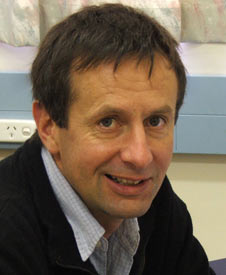 Friday 9 November 2018 4:14pm
Friday 9 November 2018 4:14pm
Dr Garry Nixon
The National Interprofessional School of Rural Health that has been proposed recently is not a separate education provider, but rather an “enabling body” that would lever off the expertise of the existing tertiary institutions to undertake more teaching and research in rural communities, working in partnership with local health services.
In an article in the latest issue of the New Zealand Medical Journal, stakeholders from the University of Otago, University of Auckland and Auckland University of Technology (AUT) outline details about their proposal which is designed to address a persisting shortage of health professionals in rural areas and to provide for New Zealand's rural health needs in the future.
The intention is to create an interprofessional community of rural health academics, dispersed across rural New Zealand and brought together on a “virtual campus”. Rural healthcare professionals will combine academic roles with active rural clinical practice.
The activities of the school would be based around nodes located in rural towns and integrated with local health services. It is proposed that a local governance group be established in each node in order to facilitate this community and iwi engagement.
Currently, rural communites have multiple points of contact with different health professional education and training programmes run by different tertiary institutions and colleges.
Dr Garry Nixon, Associate Dean Rural at the University of Otago, explains sharing human, physical and other resources would permit these institutions to educate students and undertake research in rural communities in ways currently not possible.
“It would create a community of health professional teachers and researchers in rural areas,” Dr Nixon says.
“A National Interprofessional School of Rural Health would be a significant investment in the social fabric, institution and economics of small town New Zealand.”
One central aim is to ensure students experience the realities of health delivery in rural communities by spending a significant time in rural areas. They would receive their training from people who are living and working there, not only doctors but also nurses, pharmacists, physiotherapists and mental health staff.
Professor Warwick Bagg, who heads the Medical Programme at the University of Auckland, says the long-term vision is to create a culture of rural academic development and presence.
“Based on overseas evidence we know this is likely to encourage many more health professionals to live and work in rural areas,” Professor Bagg says.
“In 2018 medical student intake at the University of Auckland mirrors the population for Māori and is approaching demographic equity at graduation. For Pacific medical students, both intake and graduation match demographic equity. The proposed NISRH will provide opportunities for those Māori from rural Aotearoa to live and learn in their communities.”
The proposal, developed last year, is a collaboration between the University of Otago, the University of Auckland, the Royal NZ College of General Practitioners and the New Zealand Rural General Practice Network. The collaboration has now grown to include AUT and will include other tertiary institutions, including those in regional centres, as it evolves.
AUT's Head of Clinical Sciences, Associate Professor Peter Larmer, says the University is excited to be involved in the project.
“AUT highly values the opportunity for students to experience rural placements and have the chance to become part of an interdisciplinary programme and link with the local community,” he says.
Globally, research indicates people living in rural towns have consistently poorer health outcomes, including lower life expectancy, than those living in cities. In New Zealand, rural towns also have the highest proportion of people identifying as Māori.
The proposed school, which is based on successful Australian models that have been adapted to the New Zealand context, would help address health inequities in rural areas for all populations.
A continuum of training would be provided from undergraduate to early and late postgraduate.
Link to open access article:
https://www.nzma.org.nz/journal/read-the-journal/all-issues/2010-2019/2018/vol-131-no-1485-9-november-2018/7741
For further information, contact:
Dr Garry Nixon
Associate Dean Rural
University of Otago
Email garry.nixon@otago.ac.nz
Professor Warwick Bagg
Head of the Medical Programme
Faculty of Medical and Health Sciences
University of Auckland
Email w.bagg@auckland.ac.nz
Associate Professor Peter J Larmer
Head School of Clinical Sciences
Faculty of Health and Environmental Sciences
Auckland University of Technology
Tel (09) 921 9999 ext 7322
Email Peter.larmer@aut.ac.nz
Liane Topham-Kindley
Senior Communications Adviser
University of Otago
Tel (03) 479 9065
Mob 021 279 9065
Email liane.topham-kindley@xtra.co.nz
Electronic addresses (including email accounts, instant messaging services, or telephone accounts) published on this page are for the sole purpose of contact with the individuals concerned, in their capacity as officers, employees or students of the University of Otago, or their respective organisation. Publication of any such electronic address is not to be taken as consent to receive unsolicited commercial electronic messages by the address holder.
FIND an Otago Expert
Use our Media Expertise Database to find an Otago researcher for media comment.
